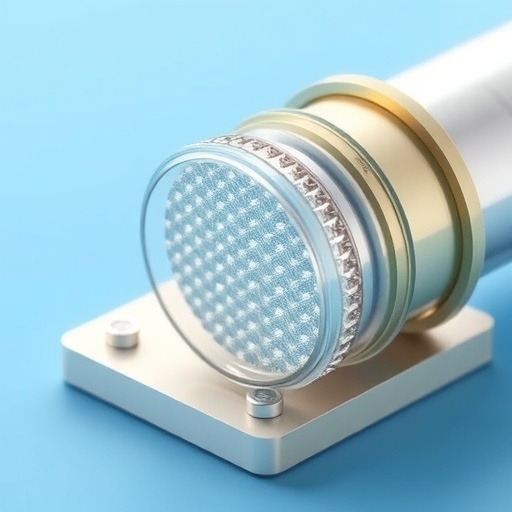In the race towards a sustainable hydrogen economy, palladium has emerged as an indispensable material, celebrated for its unique ability to selectively permit hydrogen gas to permeate while blocking all other gases. This remarkable selectivity renders palladium membranes critically valuable in industrial processes where the extraction of pure hydrogen is paramount. Yet, despite palladium’s exceptional properties, a significant challenge has persisted: the material’s vulnerability to degradation at high temperatures. Traditional palladium membranes typically falter beyond temperatures of approximately 800 kelvins, limiting their applicability in advanced hydrogen production systems that operate under extreme thermal conditions.
Recent breakthroughs by a team of engineers at the Massachusetts Institute of Technology have surmounted this barrier by pioneering a radically different membrane architecture that withstands significantly higher temperatures without compromising hydrogen selectivity. Departing from the conventional design of thin continuous films, the new membranes comprise palladium “plugs” that are precisely deposited within the microscopic pores of a porous silica support. This nanostructured design fundamentally alters the thermal dynamics of the membrane, enabling sustained performance even at temperatures reaching 1,000 kelvins—far exceeding the resilience of previous palladium membranes.
This innovation arose from a pressing need to develop materials suitable for next-generation hydrogen production techniques, such as compact steam methane reforming and ammonia cracking reactors. These processes naturally operate at elevated temperatures to maximize efficiency and hydrogen yield but require membranes that can endure such harsh environments. The MIT researchers recognized that embedding discrete palladium structures within the pores harnesses a phenomenon whereby palladium’s natural shrinkage at elevated temperatures forms stable, low-energy droplets confined by the pore walls, preventing the membrane from degrading into droplets or developing defects.
To bring this concept to fruition, the team meticulously fabricated small-scale membranes by coating a porous silica scaffold—with pore diameters around half a micron—with a thin layer of palladium. Through controlled thermal and chemical treatments, they coaxed the palladium to migrate into the pores, effectively plugging them while removing any palladium residue from the surface. The resulting membranes were subjected to rigorous testing in a custom-built experimental setup that exposed them to hydrogen-rich gases at various temperatures and durations. Impressively, the membranes maintained their structural integrity and selective hydrogen permeability even after 100 hours of continuous exposure at 1,000 kelvins.
The underlying mechanism by which palladium selectively filters hydrogen is rooted in its electronic properties. Palladium surfaces adsorb molecular hydrogen, weakening the H–H bonds and dissociating the molecule into atomic hydrogen. These atoms then diffuse through the metal lattice, recombining as pure hydrogen gas on the membrane’s opposite side. However, at elevated temperatures, conventional films tend to suffer from dewetting and agglomeration, which compromise membrane integrity and allow contaminants to pass through. The plug-based membranes circumvent this failure mode by stabilizing palladium deposits within confined spaces, effectively mitigating agglomeration.
The implications of this advancement extend across several facets of the hydrogen economy. Notably, in the realm of fusion energy—where future reactors will circulate isotopes of hydrogen like deuterium and tritium at extreme temperatures—the ability to perform hydrogen separation at reactor-adjacent, high-temperature environments can drastically simplify system designs and boost energy efficiency. Conventional systems necessitate cooling steps before membrane separation, incurring additional costs and complexity. By enabling membranes to operate closer to the source at higher temperatures, the plug membrane design promises a more compact, cost-effective approach to hydrogen isotope management.
Similarly, in industrial hydrogen production techniques, the new membranes offer transformative potential. Steam methane reforming, a cornerstone process, traditionally involves energy-intensive pre-treatment stages to condition feed gases for hydrogen extraction. Integrating palladium plug membranes directly into reforming reactors could supplant these stages, concurrently reducing system footprint, energy consumption, and capital costs. Furthermore, ammonia cracking—a process under active development that envisages ammonia as a hydrogen carrier—could leverage these membranes to efficiently harvest hydrogen at operational temperatures compatible with the plug membrane’s thermal stability, fostering safer and more practical hydrogen fuel infrastructure.
Despite the promising laboratory results, the researchers underscore that further scaling and validation are essential before commercial adoption. Long-term durability studies under realistic industrial conditions, multi-gas feed testing, and cost optimization constitute the next critical steps. However, the fundamental insight gained—demonstrating that discrete nanostructuring of palladium within pores drastically enhances thermal resilience—opens a compelling new direction for membrane design in hydrogen technology.
By marrying materials science with precise nanofabrication techniques, this innovation not only elevates palladium’s performance limits but also hints at reductions in palladium usage, a precious and costly metal, by confining it to efficient plug structures rather than continuous films. This could help lower manufacturing expenses and accelerate the deployment of hydrogen technologies globally. The MIT-led team’s work, detailed in the journal Advanced Functional Materials, marks a significant stride towards the realization of a clean, hydrogen-fueled energy future.
In conclusion, the development of nanostructured palladium plug membranes symbolizes a landmark advance in high-temperature hydrogen separation. It offers an elegant solution to longstanding thermal limitations, enabling membranes to perform robustly where traditional films fail. As the demand for hydrogen expands—from green energy to advanced manufacturing—the deployment of these membranes could profoundly reshape industrial processes, enabling more efficient, compact, and economical production routes. Empowered by this design innovation, the hydrogen economy may now take a decisive leap forward towards practical, scalable, and sustainable energy solutions.
Subject of Research: Hydrogen separation membranes with enhanced thermal stability using palladium nanostructures
Article Title: “Nanostructured Hydrogen-Selective Palladium ‘Plug’ Membranes Capable of Withstanding High Temperatures”
Web References:
http://dx.doi.org/10.1002/adfm.202516184
Image Credits: Courtesy of Rohit Karnik, et al
Keywords
Energy, Fuel, Hydrogen fuel, Energy resources, Alternative energy, Mechanical engineering, Fusion energy, Nuclear power, Nuclear power plants, Electrical power generation




